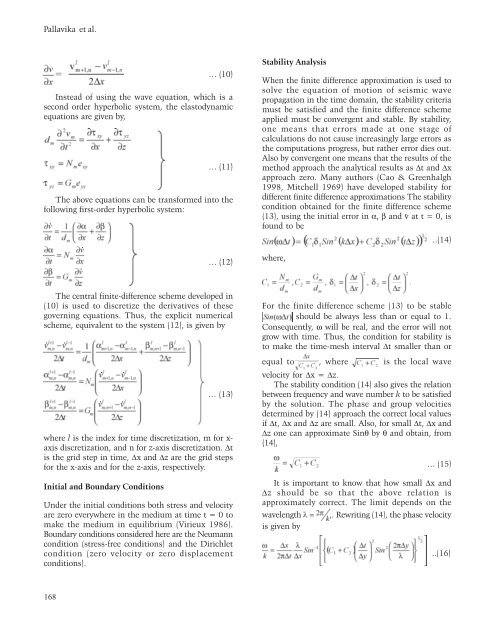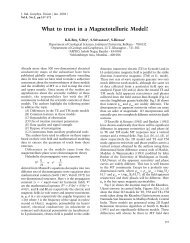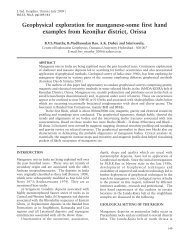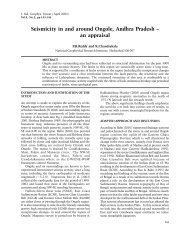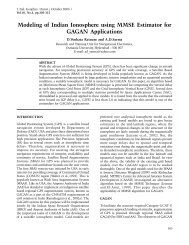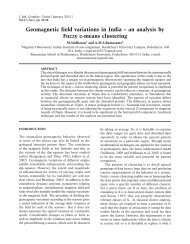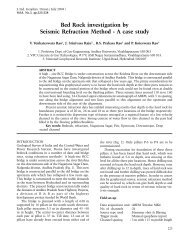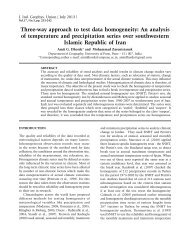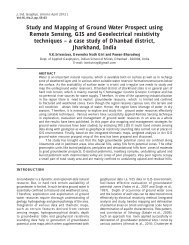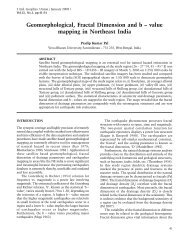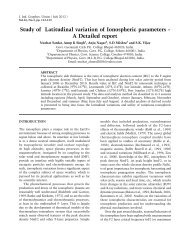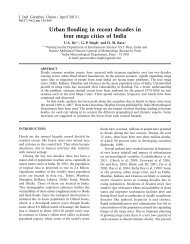Pallavika, V.K.Kalyani1, S.K.Chakraborty and Amalendu Sinha1 - IGU
Pallavika, V.K.Kalyani1, S.K.Chakraborty and Amalendu Sinha1 - IGU
Pallavika, V.K.Kalyani1, S.K.Chakraborty and Amalendu Sinha1 - IGU
You also want an ePaper? Increase the reach of your titles
YUMPU automatically turns print PDFs into web optimized ePapers that Google loves.
<strong>Pallavika</strong> et al.… (10)Instead of using the wave equation, which is asecond order hyperbolic system, the elastodynamicequations are given by,… (11)The above equations can be transformed into thefollowing first-order hyperbolic system:...… (12)Stability AnalysisWhen the finite difference approximation is used tosolve the equation of motion of seismic wavepropagation in the time domain, the stability criteriamust be satisfied <strong>and</strong> the finite difference schemeapplied must be convergent <strong>and</strong> stable. By stability,one means that errors made at one stage ofcalculations do not cause increasingly large errors asthe computations progress, but rather error dies out.Also by convergent one means that the results of themethod approach the analytical results as Δt <strong>and</strong> Δxapproach zero. Many authors (Cao & Greenhalgh1998, Mitchell 1969) have developed stability fordifferent finite difference approximations The stabilitycondition obtained for the finite difference scheme(13), using the initial error in α, β <strong>and</strong> ν.at t = 0, isfound to bewhere,..(14)The central finite-difference scheme developed in(10) is used to discretize the derivatives of thesegoverning equations. Thus, the explicit numericalscheme, equivalent to the system (12), is given by. .. .. .… (13)where l is the index for time discretization, m for x-axis discretization, <strong>and</strong> n for z-axis discretization. Δtis the grid step in time, Δx <strong>and</strong> Δz are the grid stepsfor the x-axis <strong>and</strong> for the z-axis, respectively.Initial <strong>and</strong> Boundary ConditionsUnder the initial conditions both stress <strong>and</strong> velocityare zero everywhere in the medium at time t = 0 tomake the medium in equilibrium (Virieux 1986).Boundary conditions considered here are the Neumanncondition (stress-free conditions) <strong>and</strong> the Dirichletcondition (zero velocity or zero displacementconditions).For the finite difference scheme (13) to be stableshould be always less than or equal to 1.Consequently, ω will be real, <strong>and</strong> the error will notgrow with time. Thus, the condition for stability isto make the time-mesh interval Δt smaller than orequal to , where is the local wavevelocity for Δx = Δz.The stability condition (14) also gives the relationbetween frequency <strong>and</strong> wave number k to be satisfiedby the solution. The phase <strong>and</strong> group velocitiesdetermined by (14) approach the correct local valuesif Δt, Δx <strong>and</strong> Δz are small. Also, for small Δt, Δx <strong>and</strong>Δz one can approximate Sinθ by θ <strong>and</strong> obtain, from(14),… (15)It is important to know that how small Δx <strong>and</strong>Δz should be so that the above relation isapproximately correct. The limit depends on thewavelength ,. Rewriting (14), the phase velocityis given by..(16)168


